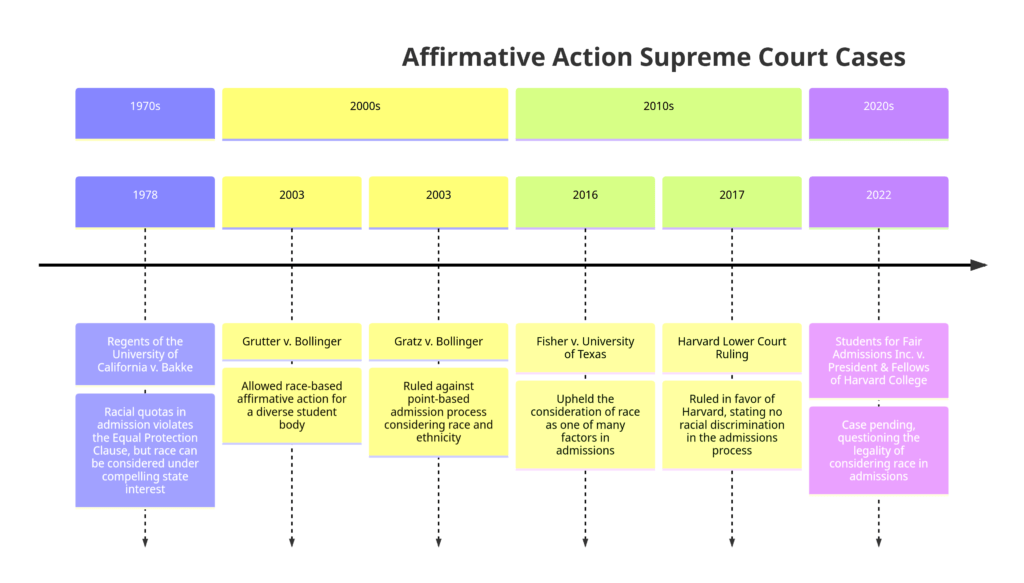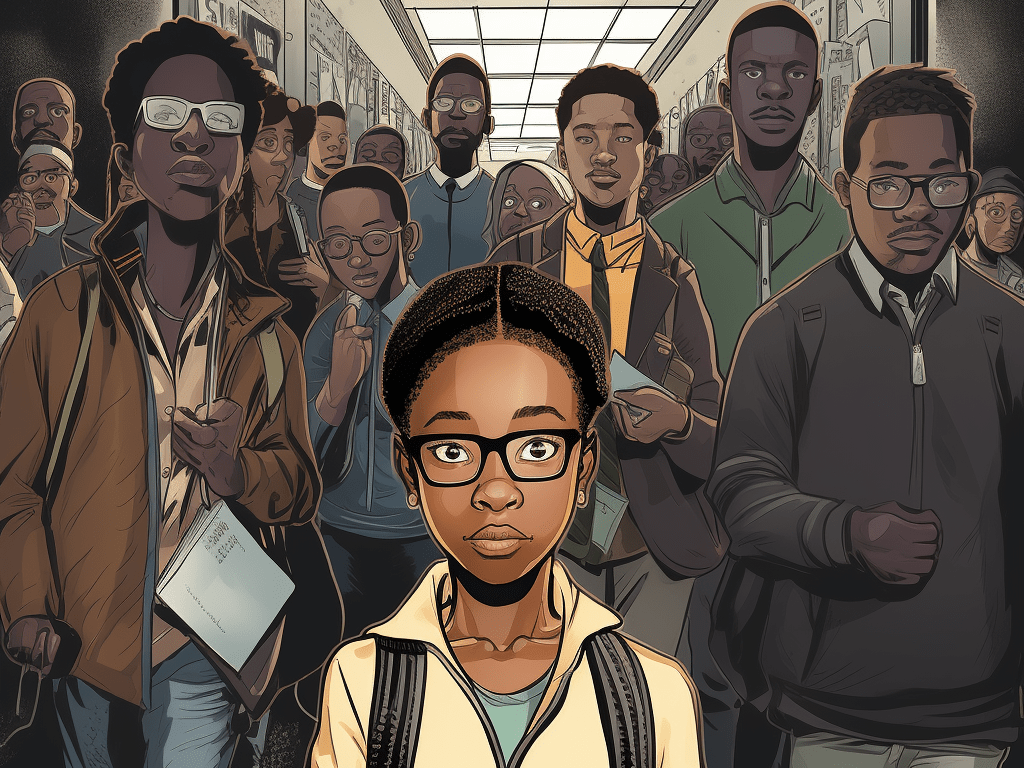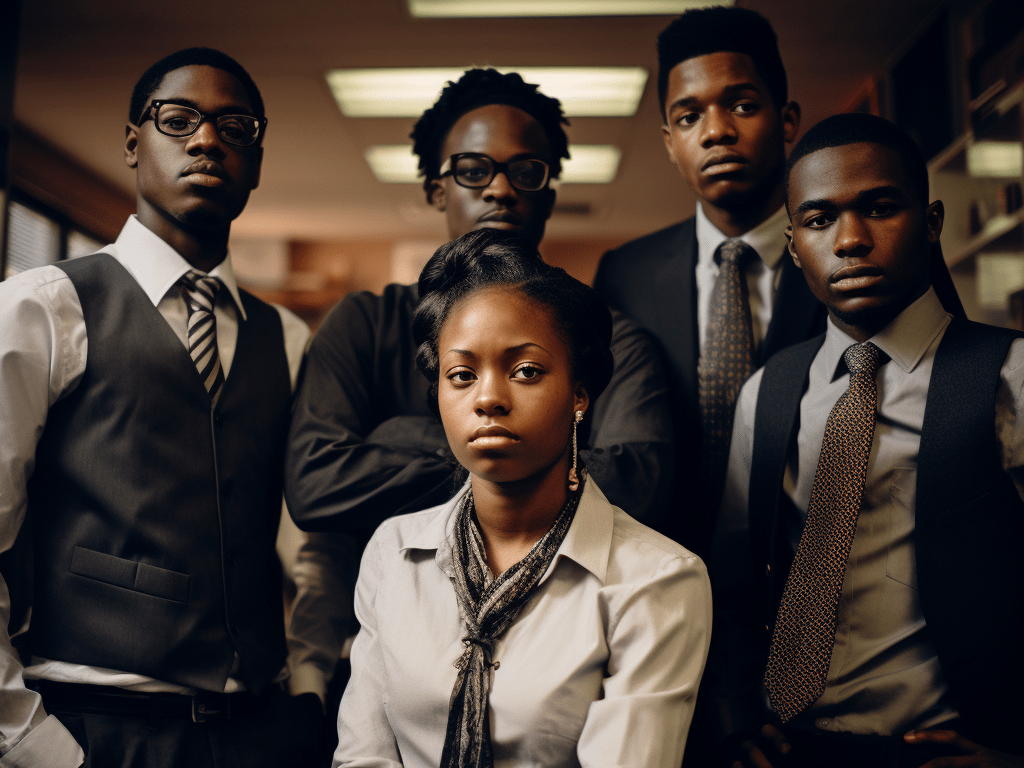*Ad Free Videos for as little as $1/Month Subscription!!*
The Supreme Court, Affirmative Action, and Racial Inequality in Education: A Deep Dive into the Controversy
African American Education Problems
“The racial disparities in our education system are not just a matter of chance or circumstance; they are the result of systemic racism that has been ingrained in our society for centuries.”
( California Department of Justice 213)
The problems facing African American education are multifaceted. They range from the underfunding of schools predominantly attended by African American students to the lack of representation in the curriculum.

The California Department of Justice report further underscores the severity of these issues. It reveals that African American students are three times more likely to be suspended or expelled than their white peers, contributing to the school-to-prison pipeline (CA DOJ 210). Additionally, African American students are less likely to have access to experienced teachers, advanced coursework, and high-quality instructional materials (CA DOJ 212).
While the systemic issues in African American education persist, there are efforts to address these disparities and promote racial diversity in higher education. One such effort is affirmative action, a policy subject to legal scrutiny and public debate. This brings us to a significant case that has brought affirmative action to the forefront of racial equality in education discussions.
Harvard Affirmative Action Case Explained
In recent years, affirmative action has faced significant legal challenges. Two cases before the Supreme Court could have far-reaching implications for universities achieving racial diversity. The lawsuits, brought by Students for Fair Admissions (SFFA), challenge the admissions policies at Harvard University and the University of North Carolina.
The plaintiffs argue that considering underrepresented ethnic minorities as one factor for admission discriminates against Asian American applicants, as they are not included as an underrepresented group. A lower court ruled in favor of Harvard in 2017, stating that the school didn’t engage in racial discrimination because the plaintiffs failed to prove that race played a role in the admissions process.
The case of Students for Fair Admissions Inc. v. President & Fellows of Harvard College is a significant legal dispute that has reached the Supreme Court of the United States. The case revolves around two main issues:
- The first issue is whether the Supreme Court should overturn a previous ruling, Grutter v. Bollinger, which allows institutions of higher education to consider race as a factor in admissions. This contentious issue touches on the broader debate about affirmative action in the United States.
- The second issue is whether Harvard College violates Title VI of the Civil Rights Act by allegedly penalizing Asian American applicants, engaging in racial balancing, overemphasizing race, and rejecting workable race-neutral alternatives. (“Students for Fair Admissions Inc. v. President & Fellows of Harvard College”)
The case was argued on October 31, 2022, but the court’s decision is still to be determined. The outcome of this case could have far-reaching implications for using race in college admissions across the United States. The case has sparked much debate and coverage, with various parties offering their perspectives on the issues at stake.
It’s important to note that the case is not just about Harvard’s admissions policies but could potentially impact how all colleges and universities in the U.S. approach admissions. The decision could either uphold the current practice of considering race as one of many factors in a holistic admissions process or significantly change the landscape of college admissions by ruling such considerations unlawful.
History of Affirmative Action in College Admissions

Affirmative action is a policy designed to achieve greater representation of ethnic minorities and women in the workplace, school, or other institutions. Introduced in the United States in the 1960s, it was an attempt to address discrimination based on race, gender, and other factors.
Regents of the University of California v. Bakke
The Regents of the University of California v. Bakke case in 1978 was the first to question the legality of affirmative action policies in higher education. Allan Bakke, a white applicant, claimed he was wrongfully denied admission to medical school at the University of California to make room for less qualified minority applicants. The U.S. Supreme Court ruled that establishing or using “racial quotas” in determining admission violates the Equal Protection Clause of the Fourteenth Amendment. However, the court ruled that race could be used in university admissions decisions if there’s a compelling state interest, as long as affirmative action programs are “narrowly tailored” to meet that interest.
Fisher v. University of Texas
The Fisher v. University of Texas case was another significant legal battle in the history of affirmative action. In 2016, the Supreme Court ruled that the University of Texas could continue to consider race as one of many factors in admissions, reaffirming the notion that affirmative action is a valuable tool to help create a diverse student body.
Grutter v. Bollinger
In the Grutter v. Bollinger case in 2003, the Supreme Court allowed the University of Michigan Law School to use race-based affirmative action to diversify its student body. The court ruled that the law school’s interest in achieving a diverse student body was a compelling state interest and that the school’s policy was narrowly tailored to achieve that interest.
In summary, the Equal Protection Clause does not prohibit the Law School’s narrowly tailored use of race in admissions decisions to further a compelling interest in obtaining the educational benefits that flow from a diverse student body. Consequently, petitioner’s statutory claims based on Title VI and 42 U.S.C. § 1981 also fail.
(Source: ballotpedia.org)
However, the Court also ruled against the University of Michigan in Gratz v. Bollinger, striking down the use of a point system awarded to ethnic minorities in undergraduate admissions.
Gratz v. Bollinger
In contrast, the Gratz v. Bollinger case in 2003 saw the Supreme Court ruling against the University of Michigan’s undergraduate College of Literature, Science, and Arts. The court ruled that the college could not use an admission process that awarded points based on an applicant’s race and ethnicity. This decision changed the future of affirmative action in the undergraduate admission process, as race and ethnicity could no longer be awarded “extra” points to help admit certain applicants.
Affirmative action policies have significantly shaped the landscape of higher education in the United States. While these policies have faced legal challenges and sparked debates, they have also opened doors for minority students and contributed to the diversity of colleges and universities.
Affirmative Action in College Admissions Debate
The debate around affirmative action in college admissions is complex and multifaceted. Critics argue that it amounts to “reverse discrimination,” while supporters see it as a critical tool to ensure a diverse student body in higher education.
In a friend of the court brief, the UC told the Supreme Court that despite its extensive efforts, UC struggles to enroll a student body that is sufficiently racially diverse to attain the educational benefits of diversity. The shortfall is especially apparent at UC’s most selective campuses where African American, Native American, and Latinx students are underrepresented and widely reported struggling with feelings of racial isolation.

Affirmative action policies have been demonstrated to be in the state’s interest as an essential tool to improve educational outcomes for all students. It is on this basis, the Supreme Court’s state interest doctrine rests. The courts have been vague about how or to what extent to take race and gender into account, leading to ongoing debates and legal challenges. The current Supreme Court cases could potentially upend decades of legal precedent. If the Court strikes down affirmative action, it will likely mean that colleges and universities can no longer use race-conscious admissions practices.
In addition, race-conscious admissions policies are necessary to promote racial diversity in ways that are focused on socio-economic status alone cannot. For example, admission based on socioeconomic status fails to take into account racial inequality. Students of Color are more likely than white students to attend underfunded and highly segregated public schools. Black students also face suspension and expulsion disproportionately as compared to white students (CA DOJ 18).
Unequal Opportunity, Race, and Education
The American education system, often hailed as a great equalizer, has been marred by stark racial disparities. These disparities are not just a matter of socioeconomic status; they are deeply rooted in a history of systemic racism that continues to perpetuate inequality. As an educational platform dedicated to Black history and racial justice, African Elements is committed to shedding light on these issues and advocating for change.
The California Department of Justice’s 2022 report on reparations for African Americans comprehensively examines racial inequality in education (CA DOJ 206). The report reveals that African American students are more likely to attend underfunded schools, have less access to advanced coursework, and are disproportionately disciplined compared to their white counterparts (CA DOJ 207). These disparities have profound implications for the educational opportunities available to African American students and their subsequent life outcomes.
How Does Race Affect Education Opportunities

Race plays a significant role in shaping educational opportunities. The systemic racism in our education system creates barriers disproportionately affecting African American students. For instance, African American students are more likely to attend schools in low-income neighborhoods, often underfunded and lacking the resources necessary to provide a high-quality education.
The California Department of Justice report provides a stark illustration of this issue. It reveals that African American students are more likely to attend schools in the lowest quartile of funding, which significantly impacts their educational opportunities (CA DOJ 215). Furthermore, African American students are less likely to have access to advanced coursework, which can limit their college and career prospects (CA DOJ 217).
Schools with fewer resources mean fewer Advanced Placement and college preparation courses, which means that Black students attending those schools are less competitive for college and university admission and may not have taken the courses necessary to go to a four-year state University.
(CA DOJ 224)
Despite the Supreme Court’s landmark 1954 Brown v. Board of Education of Topeka, Kansas decision, which ruled segregation unconstitutional, Black children have remained in underperforming schools for decades. After Brown, where districts and schools were marginally integrated, Black students faced segregation by other means.
Federal, state, and local housing segregation policies, including redlining and restrictive covenants, forced the vast majority of African Americans to live in separate communities from white Americans.
(CA DOJ 215)
As of 2020, California remained in the country’s top 10 most segregated states for Black students. Approximately 64 percent of Black students in California attend hyper-segregated, 90- to 100-percent nonwhite schools ( CA DOJ 223).
The impact of race on education opportunities is further highlighted in the California reparations initiative. This initiative acknowledges the systemic racism that has perpetuated educational inequality and seeks to address these injustices through reparations.
Educational Inequality Examples
The racial disparities in our education system are not abstract; they have real, tangible impacts on the lives of African American students. For instance, the California Department of Justice report reveals that African American students are less likely to graduate high school on time than their white peers (CA DOJ 220). This affects their immediate educational prospects and has long-term implications for their career opportunities and earning potential.
Another striking example of educational inequality is the racial achievement gap. Despite efforts to close this gap, African American students continue to lag behind their white peers in standardized test scores. This disparity is often attributed to their unequal resources and opportunities (CA DOJ 221).
“The racial achievement gap is not a reflection of the abilities of African American students, but rather a reflection of the systemic barriers they face in our education system.” (CA DOJ 222)
The report also highlights the discriminatory use of SAT and ACT scores in college admissions, which often serve as proxies for wealth and race. This practice exacerbates existing inequalities and can deter African American students from pursuing higher education (CA DOJ 223).
How Does Race Affect College Admissions?

Race plays a significant role in college admissions, particularly in institutions that strive to maintain a diverse student body. Affirmative action policies allow these institutions to consider race as one factor among many in their admissions processes.
However, the impact of race on college admissions extends beyond affirmative action. Students of color are more likely than white students to attend underfunded and highly segregated public schools, which can impact their academic preparation and college readiness. Moreover, Black students face suspension and expulsion disproportionately compared to white students, further hindering their educational opportunities. These systemic issues underscore the need for policies like affirmative action that aim to level the playing field and promote diversity in higher education.
Diversity Matters: Why Affirmative Action is Necessary
With American society becoming increasingly diverse, it is important to reflect that diversity in our institutions. Studies have shown that diverse environments produce better educational outcomes.
Evidence gathered by the Century Foundation suggests that racially integrated classrooms can reduce students’ racial bias, improve satisfaction and intellectual self-confidence, and enhance leadership skills. These benefits may translate to better economic outcomes and, among other payoffs, prepare students to work in a diverse global economy , increasing the productivity, effectiveness, and creativity of teams.
(Source: americanprogress.org)
In 1996, California voters passed Prop 209, banning consideration of race in college admissions. The state’s UC system admitted that despite its eliminating race-neutral measures such as standardized tests, it still struggles to bring minority representation to UC’s student body. In a friend of the court brief,
UC told the Supreme Court that “despite its extensive efforts, UC struggles to enroll a student body that is sufficiently racially diverse to attain the educational benefits of diversity. The shortfall is especially apparent at UC’s most selective campuses, where African American, Native American, and Latinx students are underrepresented and widely report struggling with feelings of racial isolation.
(Source: kqed.org)
Racial inequality in education is a pervasive issue that requires urgent attention. The disparities highlighted in the California Department of Justice report and the examples provided by African Elements underscore the urgent need for systemic change.
The fight for racial justice in education is far from over. As we continue to grapple with the legacy of systemic racism, it is crucial that we acknowledge these disparities and work towards creating an education system that provides equal opportunities for all students, regardless of their race.
In the words of the California Department of Justice, “The racial disparities in our education system are not just a matter of chance or circumstance; they are the result of systemic racism that has been ingrained in our society for centuries” (CA DOJ 233). It’s time we confront this reality and work towards creating a more equitable education system for all.
Conclusion
“Education is the most powerful weapon which you can use to change the world.”
– Nelson Mandela
As we look to the future, the Supreme Court’s upcoming decisions could significantly impact the landscape of affirmative action. If the court strikes down these policies, universities may need to find new ways to promote diversity and equal opportunity. However, regardless of the legal outcomes, the conversation surrounding affirmative action is far from over. This conversation requires us to confront difficult questions about race, equality, and justice in our society.
California’s Reparations Task Force is a step in the right direction, acknowledging the systemic racism that has perpetuated educational inequality and seeking to address these injustices through reparations. However, there is still much work to be done. Our collective responsibility is to ensure that all students have access to the resources and opportunities they need to succeed.
Ultimately, the goal should be to create an educational environment that reflects the diversity of our society and provides equal opportunities for all students. Affirmative action, in its various forms, has been one method of striving toward this goal. As we continue to grapple with these issues, it’s essential to remember the ultimate objective: a fair, equitable, and inclusive system of higher education that prepares all students to succeed in an increasingly diverse and global society.
SOURCES
Bedekovics, Greta. “5 Reasons to Support Affirmative Action in College Admissions.” Center for American Progress, 1 October 2019, https://www.americanprogress.org/article/5-reasons-support-affirmative-action-college-admissions/. Accessed 15 November 2022.
Burke, Michael. “The Supreme Court Is Slated to Hear a Major Affirmative Action Case. University of California Offers a Cautionary Tale.” KQED, 14 October 2022, https://www.kqed.org/news/11928967/the-supreme-court-is-slated-to-hear-a-major-affirmative-action-case-university-of-california-offers-a-cautionary-tale. Accessed 16 November 2022.
KENNEDY, JUSTICE. “Grutter v. Bollinger, 539 U.S. 306.” Casetext, https://casetext.com/case/grutter-v-bollinger-et-al. Accessed 15 November 2022.
“Students for Fair Admissions Inc. v. President & Fellows of Harvard College.” SCOTUSblog, https://www.scotusblog.com/case-files/cases/students-for-fair-admissions-inc-v-president-fellows-of-harvard-college/. Accessed 26 June 2023.
